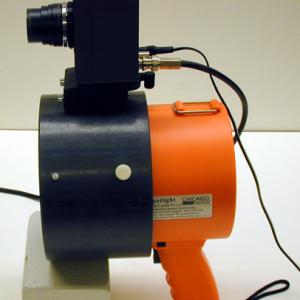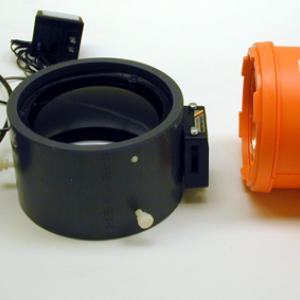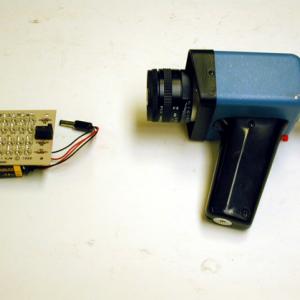College of Liberal Arts & Sciences
5N30.45 - Infrared Viewer & I. R. Projector
The FLIR camera has a temperature range of -25 to 231 degrees F. Just point at the audience and be amazed. Some interesting things to try:
- Place your hand on the lecture bench for several seconds and then look at that spot with the camera up to 2 or 3 minutes later.
- Blow up a balloon that you can not see through and place this in front of the camera lens. You can see the audience just as if the balloon was not there.
- Chill your arm in ice water for as long as you can stand it. Pull the arm out and dry it off. Look at it with the camera and see the arteries, veins, and muscles.
Assemble the spotlight/filter/camera apparatus. Turn out the lights so you have an absolutely dark room. When the trigger of the spotlight is pulled a beam of infrared radiation will then illuminate objects that the camera can see.
NOTE: Most black and white CCD cameras are very sensitive in the near infrared.
For single person viewing the commercial unit works well, especially for viewing infrared laser beams.
The kit illuminators can be used as supplemental illumination.
- Yi Jinn Lillian Chen, Jing-Yuan Ko, Shuo Hong Wang, Jiann-Shing Lih, Tzu-Chun Chen, Jeng-Fung Hung, "Ultraviolet and Infrared Light Blocked by Glass? Verifying Through Simple Experiments, "TPT, Vol. 62, #4, April 2024, p. 299.
- Philip G. Sieg, William Berner, Peter K. Harnish and Philip C. Nelson, "A Demonstration of the Infrared Activity of Carbon Dioxide", TPT, Vol. 57, #4, Apr. 2019, p. 246.
- Petr Kácovský, "Thermal Imaging Experiments as an Inspiration for Problem-Based Learning", TPT, Vol. 56, #9, Dec. 2018, p. 596.
- Emil Melander, Jesper Haglund, Matthias Weiszflog, and Staffan Andersson, "More than Meets the Eye – Infrared Cameras in Open-Ended University Thermodynamics Labs", TPT, Vol. 54, #9, Dec. 2016, p. 528.
- Jochen Kuhn and Patrik Vogt, "Diffraction Experiments with Infrared Remote Controls", TPT, Vol. 50, #2, Feb. 2012, p. 118.
- Charles Xie and Edmund Hazzard, "Infrared Imaging for Inquiry-Based Learning", TPT, Vol. 49, #6, Sept. 2011, p. 368.
- Michael Vollmer, Klaus-Peter Möllmann, Frank Pinno, and Detlef Karstädt, "There Is More To See Than Eyes Can Detect", TPT, Vol. 39, #6, Sept. 2001, p. 371.
- Erin E. Pursell and Richard Kozlowski, "Infrared Radiation: Herschel Revisited", TPT, Vol. 38, #9, Dec. 2000, p. 559.
- William Shanks, Edward J. Carlone, and William Blunk, "A Blue-Hot Giveaway for Your Group", TPT, Vol. 20, #3, Mar. 1982, p. 181.
- Barry N. Lightfoot, "Infrared Telescope", TPT, Vol. 17, #2, Feb. 1979, p. 132.
- Dudley Williams, "Infrared Radiation", TPT, Vol. 1, #5, Nov. 1963, p. 212.
- N. A. Gross, M. Hersek, and A. Bansil, "Visualizing Infrared Phenomena With a Webcam", AJP, Vol. 73, #10, Oct. 2005, p. 986.
- Stanley J. Micklavzina, "Tricks with Invisible Light", Physics Education, Vol. 38, #6, Nov. 2003, p. 492.
- Donald G. Mooney, "The Amateur Scientist: Seeing Infrared", Scientific American, Vol. 266, #3, Mar. 1992, p. 112.
- C. L. Stong, "The Amateur Scientist: A Simple Laser Interferometer, an Inexpensive Infrared Viewer and Simulated Chromatograms", Scientific American, Vol. 226, #2, Feb. 1972, p. 106.
- Gorazd Planinsic, "A Photoshoot for Food and Drink: Camera Sees More Than You Think", Physics Education, Vol. 39, #1, Jan. 2004, p. 32.
- Tom Gibson, "Seeing in the Dark", How it Works, Science Supplement, Spring 2000, p. 248 - 255.
- Borislaw Bilash II and David Maiullo, "Hear the Light", A Demo a Day: A Year of Physics Demonstrations, p. 317.
- Martin C. Sagendorf, "45. Infra-Red [Night] Vision - A Demonstration", Physics Demonstration Apparatus, 2009. p. 138 - 141.
- Martin C. Sagendorf, "42. What You Can't See - Infra-Red", Physics Demonstration Apparatus, 2009. p. 125 - 130.
- Brian Jones and Matt Fackelman, "Infrared Images: Not Only Does the Camera Add Ten Pounds...", Don't Forget the Duct Tape: Little Shop of Physics, p. 61 - 64.
- Ron Hipschman, "Recipe No. 126. Low Frequency Light", Exploratorium Cookbook II, 1980, p. 126-1 - 126-4.
- Rick Beyer, "Surfing Safari", The Greatest Science Stories Never Told, p. 168 - 169.
Disclaimer: These demonstrations are provided only for illustrative use by persons affiliated with The University of Iowa and only under the direction of a trained instructor or physicist. The University of Iowa is not responsible for demonstrations performed by those using their own equipment or who choose to use this reference material for their own purpose. The demonstrations included here are within the public domain and can be found in materials contained in libraries, bookstores, and through electronic sources. Performing all or any portion of any of these demonstrations, with or without revisions not depicted here entails inherent risks. These risks include, without limitation, bodily injury (and possibly death), including risks to health that may be temporary or permanent and that may exacerbate a pre-existing medical condition; and property loss or damage. Anyone performing any part of these demonstrations, even with revisions, knowingly and voluntarily assumes all risks associated with them.


